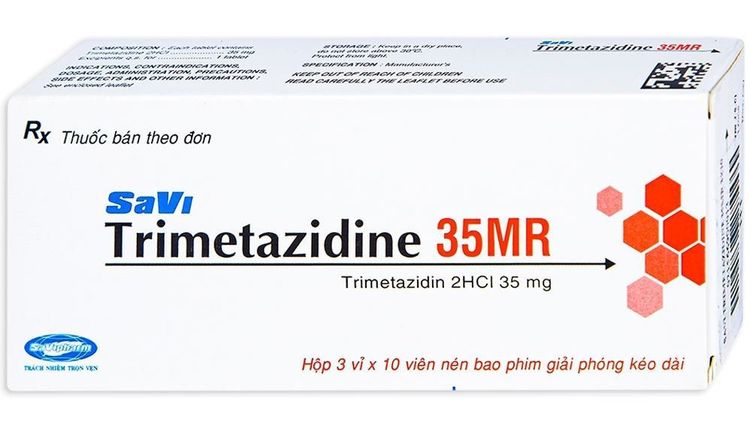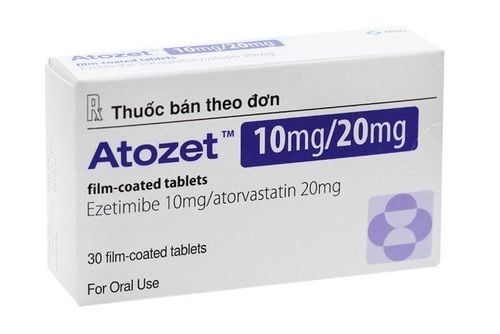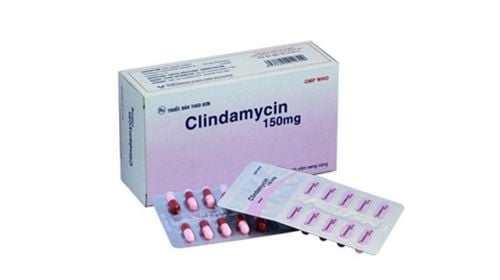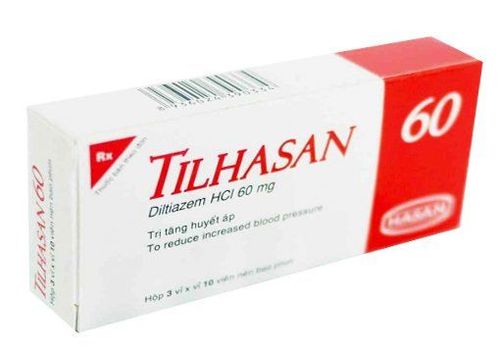This is an automatically translated article.
Trimetazidine 35Mr contains the active ingredient Trimetazidine dihydrochloride, which is formulated as an extended release. Drugs that are used as an adjunct to or as an adjunct to existing therapy, intended for the symptomatic treatment of patients with inadequately controlled stable angina or intolerant of other therapies. other angina treatment. Let's learn about the uses of Trimetazidine 35Mr through the article below.
1. Uses of Trimetazidine 35Mr
1.1. Pharmacokinetics Each film-coated tablet of Trimetazidine 35Mr contains 35mg of the active ingredient Trimetazidine dihydrochloride, which is indicated in the following medical conditions:
As an adjunct to or as an adjunct to existing therapies for symptomatic treatment. symptoms in patients with unstable angina that is not adequately controlled; As an adjunct or adjunct to treatment in patients intolerant of other angina therapies. 1.2. Pharmacodynamics Mechanism of action: The active ingredient Trimetazidine in the drug acts by inhibiting the beta-oxidation of fatty acids through the inhibition of enzymes in ischemic cells called long-chain 3-ketoacyl. CoA thiolase. The amount of oxygen consumed from glucose oxidation is less than from beta oxidation. Therefore, promoting glucose oxidation will help optimize cellular energy processes, thereby helping to metabolize energy more appropriately during times of inadequate blood supply. Pharmacodynamics: In patients with ischemic heart disease, the activity of trimetazidine as a metabolite helps to conserve intracellular phosphate energy levels that are consistently high in cardiomyocytes. The anti-ischemic effect of trimetazidine does not affect hemodynamics.
1.3. Pharmacokinetics: Trimetazidine 35Mr after oral administration is rapidly absorbed into the systemic circulation and reaches peak plasma concentrations about 2 hours before dosing. Following a single 20 mg dose of trimetazidine, maximum plasma concentrations are approximately 55 ng/ml and steady state is achieved within 24 to 36 hours for the booster dose and steady state. during treatment. The volume of distribution (Vd) of the drug in plasma is 4.8 l/kg, indicating good diffusion of trimetazidine to body tissues. Studies have also demonstrated that plasma protein binding of the drug is about 16%, with a half-life (t1/2) of 6 hours. Trimetazidine is excreted mainly in the urine as unchanged drug.

Hình ảnh thuốc Trimetazidine 35Mr
2. Drug dosage
Trimetazidin 35 is used orally, the dose depends on the patient's condition and pathophysiology, specifically as follows:
Usual dose: Take 1 tablet x 2 times a day, take the drug with meals; For patients with renal failure (creatinine clearance from 30 to 60ml), the recommended dose of Trimetazidin 35Mr is 1 tablet in the morning, taken with meals; Elderly patients: Sensitivity to trimetazidine in these patients is higher than normal due to age-related decline in renal function. The recommended dose for the elderly with a creatinine clearance of 30-60ml is 1 tablet in the morning, taken with a meal. Note and caution when calculating the dose of Trimetazidine in elderly patients; Children under 18 years of age: There are no studies to demonstrate the safety of trimetazidine in children under 18 years of age.
3. Side effects of drugs
Some possible side effects when taking Trimetazidin 35Mr are as follows:
Nervous system disorders: Symptoms may be encountered when nervous system disorders include headache, dizziness. The frequency of these side effects is unknown, but patients may also experience symptoms of Parkinson's disease (eg, bradykinesia, tremor, increased muscle tone), restless legs syndrome, unsteady gait, Other related movement disorders, sleep disturbances (drowsiness, insomnia). These side effects will disappear when the drug is stopped. Cardiac disorders: This is a rare side effect with symptoms such as extrasystoles, palpitations, tachycardia. Vascular disorders: Rare side effects. Patients may have symptoms of arterial hypotension, dizziness, fall, orthostatic hypotension combined with discomfort, especially in patients being treated with antihypertensive drugs, which will easily cause facial flushing. . Gastrointestinal disorders: Common side effects with symptoms such as diarrhea, abdominal pain, nausea and vomiting, constipation. Skin and Subcutaneous Tissue Disorders: Common side effects are pruritus, rash, urticaria. In addition, patients may present with an acute generalized pustular rash (AGEP), angioedema with an unspecified frequency. Systemic disorders: The most common symptom is asthenia. Blood and lymphatic system disorders: Trimetazidine can cause thrombocytopenia, agranulocytosis, thrombocytopenic purpura. Hepatobiliary disorders: Trimetazidine 35Mr can cause hepatitis as a side effect.

Đau bụng là một trong các tác dụng phụ của thuốc Trimetazidine 35mr
4. Note when using Trimetazidine drug
4.1. Contraindications The use of Trimetazidine is contraindicated in the following cases:
Patients with hypersensitivity to any of the active ingredients or excipients of the drug; People with Parkinson's disease, restless legs syndrome, tremor, patients with Parkinson's symptoms and other related movement disorders; Patients with severe renal impairment (renal creatinine clearance less than 30ml/min). 4.2. General Note Some cautions when using Trimetazidine 35Mr drug in treatment as follows:
Trimetazidine 35Mr drug can lead to or worsen symptoms of Parkinson's disease (slow movement, difficulty, tremor, increased muscle tone). ). Therefore, patients need to be checked regularly, especially for the elderly. When in doubt, patients need to go to specialized medical facilities for appropriate examination; Patients with symptoms similar to Parkinson's, tremor, restless legs syndrome, unsteady gait should stop taking trimetazidine. Although the incidence of these symptoms is low and patients can recover after stopping the drug (about 4 months after stopping the drug); Patients treated with trimetazidine are prone to falls due to hypotension or unsteady gait, especially in patients taking antihypertensive drugs; Caution should be exercised when prescribing Trimetazidin 35Mr to highly sensitive patients such as patients over 75 years of age, with moderate renal impairment.
4.3. Effects of the drug on special populations Pregnant and lactating women: There are no clinical studies on the safety of Trimetazidine in pregnant and lactating women. Therefore, it is not recommended to use the drug in the treatment of these subjects. Drivers and machine operators: Trimetazidine 35Mr can cause symptoms such as drowsiness, dizziness, so it may affect the ability to operate machines and drive.
5. Drug interactions
No adverse interactions between Trimetazidine 35Mr and other drugs have been recorded in clinical practice. However, to ensure safety and effectiveness in treatment, patients need to inform their doctor about all medicines they are using, do not stop or change the dose of Trimetazidine without the consent of the doctor. treatment. Trimetazidine 35Mr is indicated for the symptomatic treatment of patients with inadequately controlled stable angina or intolerant of other angina therapies. To ensure the effectiveness of treatment, as well as avoid side effects, patients need to use the drug exactly as directed by the doctor or pharmacist.
Please dial HOTLINE for more information or register for an appointment HERE. Download MyVinmec app to make appointments faster and to manage your bookings easily.













